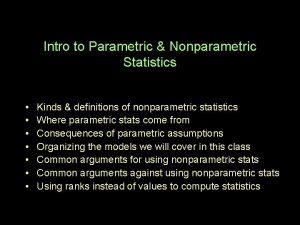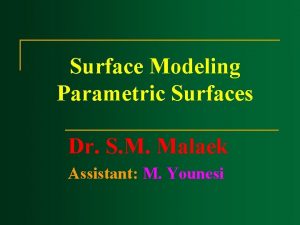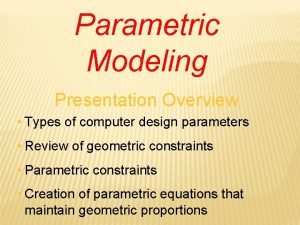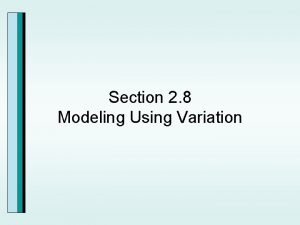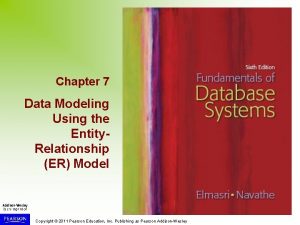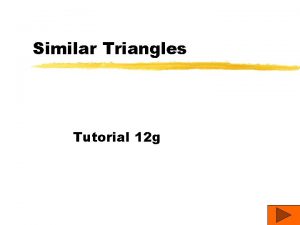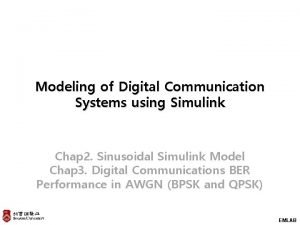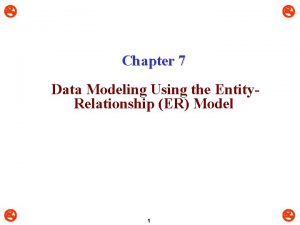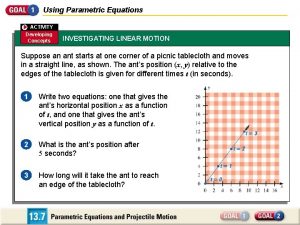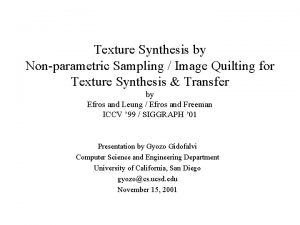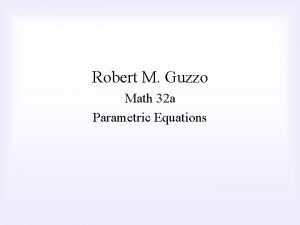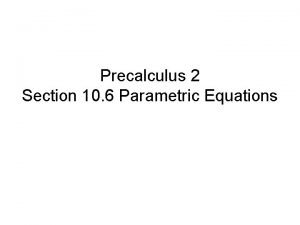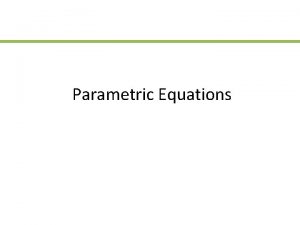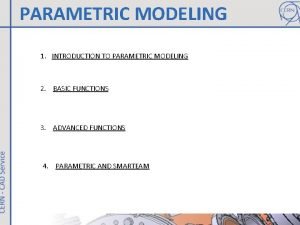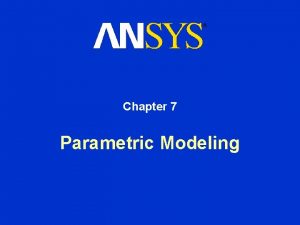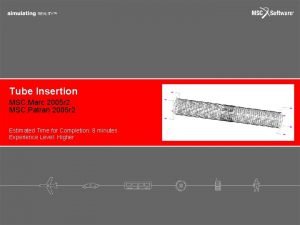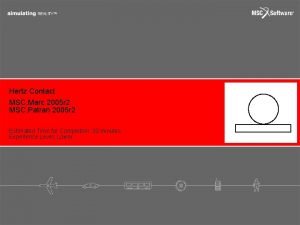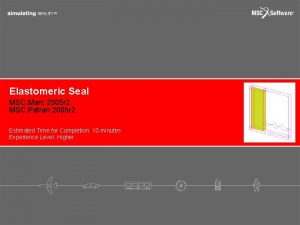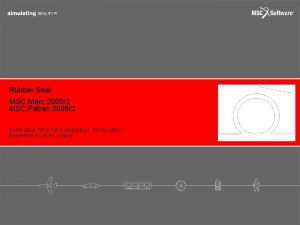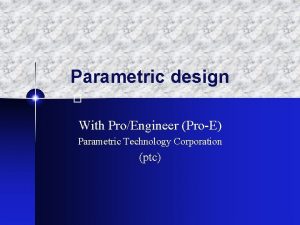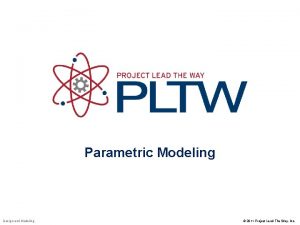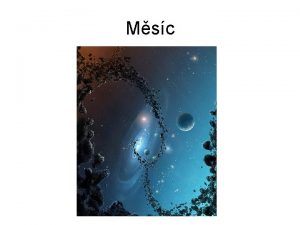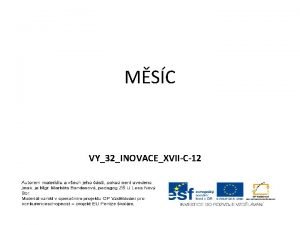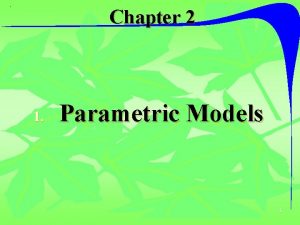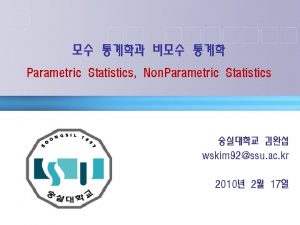Spring Design using Parametric Modeling MSC Marc 2005




















- Slides: 20

Spring Design using Parametric Modeling MSC. Marc 2005 r 2 MSC. Patran 2005 r 2 Estimated Time for Completion: 30 minutes Experience Level: Lower

Topics Covered • • • Using Parametric Modeling tool Modifying Session file Playing Session file Creating Database file for input values for parameters Creating 3 D solid elements Applying Displacement and Load boundary conditions 2

Problem Description • This example illustrate how design modification process can be accelerated by using Parametric Modeling tool and modifying the Session file. After developing the first model of a Helical Spring, design modification is done by changing the values of design parameters. 3

Summary of Model Load applied r 2 Design parameters r 1 Fixed boundary condition 4

Create DB file and Define Design Parameters a. b. c. d. e. f. g. h. i. j. k. l. m. n. o. p. q. r. s. t. u. Click File menu / Select New a In File Name enter spring. db Click OK In Approximate Maximum Model Dimension, enter 0. 1 Select Analysis Code to be MSC. Marc Click OK Click Tools menu > Pre Release > Parametric Modeling… Select Action to be Create Select Object to be Variables In Variable Name, enter r 1 In Current Value, enter 20 e-3 Click Apply. You can use Tab button In Variable Name, enter r 2 here to move the cursor. In Current Value, enter 3 e-2 Click Apply Select Action to be Create Select Object to be Macros In Macro Name, enter GEL In Macro Definition, enter ~r 2~*2 Click Apply Click Done d e b c f p q h i r s g j m k n l o t 5 u

Modeling g b h c a a. b. c. d. e. f. g. h. i. j. k. l. m. i d Click Geometry icon Select Action to be Create Select Object to be Curve Select Method to be XYZ In Vector Coordinates List, enter <0, 0. 005, 0> Click Apply Select Action to be Transform Select Object to be Curve Select Method to be Translate In Direction Vector, enter <0, 0. 005, 0> In Repeat Count, enter 19 In Curve List, enter Curve 1 or select the one just made using the mouse left button. Click Apply if Auto Execute is not selected e f j k l m 6

Modeling a. b. c. d. e. f. g. h. i. j. k. l. m. n. o. p. Select Action to be Create Select Object to be Curve Select Method to be 2 D Arc. Angles In Radius, enter `r 1` In End Angle, enter 90 In Construction Plane List, enter Coord 0. 2 or Select the coordinates icon with number 2, and select the default coordinates. Click Apply Select Action to be Transform Select Object to be Curve Select Method to be Rotate In Axis, enter Coord 0. 2 In Rotation Angle, enter 90 In Repeat Count, enter 3 In Curve List, enter Curve 21 or select the curve just made. Click Apply if Auto Execute is not selected a i b j c k d Use Grave instead Apostrophe. e l m n f h o p g 7

Modeling a. b. c. d. e. f. g. h. i. j. k. l. m. n. o. p. q. r. s. t. u. Select Action to be Transform Select Object to be Curve Select Method to be Vsum In Curve 1 List, enter Curve 1: 20 In Curve 2 List, enter Curve 21: 24 21: 24 Click Apply if Auto Execute is not selected Select Action to be Create Select Object to be Curve Select Method to be 2 D Normal In Curve Length, enter `r 2` In Construction Plane List, enter Coord 0. 2 0. 3 In Point List, enter Point 22 In Curve List, enter Curve 25 Click Apply if Auto Execute is not selected Select Action to be Create Select Object to be Coord Select Method to be 3 Point In Origin, enter Point 22 In Point on Axis 3, enter Point 47 In Point on Plane 1 -3, enter Point 46 Click Apply if Auto Execute is not selected a g b h c o p i q j r s t k d u e f l m n 8

Modeling a. b. c. d. e. f. g. h. i. j. k. l. m. n. o. Select Action to be Create Select Object to be Curve Select Method to be Revolve In Axis, enter Coord 1. 2 In Total Angle, enter 90 In Point List, enter Point 47 Click Apply if Auto Execute is not selected Select Action to be Transform Select Object to be Curve Select Method to be Rotate In Axis, enter Coord 1. 2 In Rotation Angle, enter 90 In Repeat Count, enter 3 In Curve List, enter Curve 47 Click Apply if Auto Execute is not selected a h i b j c k d l e m f g n o 9

Modeling a. b. c. d. e. f. g. h. i. j. k. l. m. n. o. Select Action to be Create Select Object to be Surface Select Method to be Edge In Surface Edge 1 List, enter Curve 47 In Surface Edge 2 List, enter Curve 48 In Surface Edge 3 List, enter Curve 49 In Surface Edge 4 List, enter Curve 50 Click Apply if Auto Execute is not selected Select Action to be Create Select Object to be Solid Select Method to be Glide Select Normal Project Glide radio button In Director Curve List, enter Curve 25: 44 In Base Surface List, enter Surface 1 Click Apply if Auto Execute is not selected a i b j c k l d m e n f o g h 10

Meshing a a. b. c. d. e. f. g. h. i. j. k. Click Element icon Select Action to be Create Select Object to be Mesh Select Method to be Solid Click Tet. Mesh Parameter In Global Edge Length*, enter 0. 5 Click OK In Input List, enter Solid 1: 20 Off the Autmatic Calculation Check box In Value, enter `GEL()` Click Apply b c d e f h i j g k 11

Applying Load and Boundary Condition a a. b. c. d. e. f. g. h. i. j. k. l. m. Click Loads/BCs icon Select Action to be Create Select Object to be Displacement Select Type to be Nodal In New Set Name, enter fixed_end Click Input Data… In Translations, enter <0, 0, 0> Click OK Click Select Application Region… In Select Geometry Entities, enter Solid 1. 5 Click Add Click OK Click Apply b g c d j k h l e f i m 12

Applying Load and Boundary Condition a a. b. c. d. e. f. g. h. i. j. k. l. m. Click Loads/BCs icon Select Action to be Create Select Object to be Force Select Type to be Nodal In New Set Name, enter forceup Click Input Data… In Translations, enter <0, 1, 0> Click OK Click Select Application Region… In Select Geometry Entities, enter Solid 20. 6 Click Add Click OK Click Apply b g c d j k h l e f i m 13

Creating Material Properties a a. b. c. d. e. f. g. h. i. j. Click Materials icon Select Action to be Create Select Object to be Isotropic Select Method to be Manual Input In Material Name, enter aluminum Click Input Data… In Elastic Modulus, enter 7 e 10 In Posson Ratio, enter 0. 33 Click OK Click Apply b c g h d e i f j 14

Creating Element Properties a a. b. c. d. e. f. g. h. i. j. k. Click Properties icon Select Action to be Create Select Object to be 3 D Select Type to be Solid In Property Set Name, enter spring Click Input Properties… In Material Name, enter m: aluminum Click OK In Select Members, enter Solid 1: 20 Click Add Click Apply b c d g e f h i j k 15

Running Analysis and Reading Results a a. b. c. d. e. f. g. h. i. j. k. Click Analysis icon Select Action to be Analyze Select Object to be Entire Model Select Method to be Full Run In Job Name, enter spring_ext Click Apply Select Action to be Read Results Select Object to be Result Entities Select Method to be Attach In Job Name, enter spring_ext Click Apply b g c h d e i j f k 16

Creating Database File and Modifying Session File a. b. c. d. e. a. b. c. Click the mouse right button In the popup menu, New > Text Document. Create new file named, my_config. dat Edit and Add following two lines to the file. r 1=30 e-3 r 2=3 -e-3 Save and Exit the file Edit the session file, spring. ses, which has been made automatically by MSC. Patran. Add the following line at the first line. parametric_modeling_util. define_user_config_file("my_config. dat") Save and Exit the file 17

Running the Session file a. b. c. d. Click File menu Select Session > Play… In File Name enter spring. ses or click the file Click Apply Note: Session file and the Parameter database file must be in the same folder. 18

Expected Results (Displacement) Max displacement = 1. 49 e-2 19

Expected Results (Displacement) Max displacement = 1. 41 e-3 20
 Bmk+
Bmk+ Parametric and non parametric test
Parametric and non parametric test Parametric and non parametric algorithms
Parametric and non parametric algorithms Parametric
Parametric Parametric surface modeling
Parametric surface modeling Helen c. erickson nursing theory
Helen c. erickson nursing theory Relational modeling vs dimensional modeling
Relational modeling vs dimensional modeling Parametric design ppt
Parametric design ppt Four seasons korean movie
Four seasons korean movie Spring summer fall winter and spring
Spring summer fall winter and spring Modeling using variation calculator
Modeling using variation calculator Data modeling using entity relationship model
Data modeling using entity relationship model Lesson 12 modeling using similarity
Lesson 12 modeling using similarity Modeling of digital communication systems using simulink
Modeling of digital communication systems using simulink Modeling of digital communication systems using simulink
Modeling of digital communication systems using simulink Er model diagram
Er model diagram How to solve parametric equations
How to solve parametric equations Texture synthesis by non-parametric sampling
Texture synthesis by non-parametric sampling Parametric equations word problems
Parametric equations word problems Matplotlib example plot
Matplotlib example plot Parametic equations
Parametic equations



